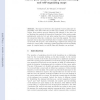Free Online Productivity Tools
i2Speak
i2Symbol
i2OCR
iTex2Img
iWeb2Print
iWeb2Shot
i2Type
iPdf2Split
iPdf2Merge
i2Bopomofo
i2Arabic
i2Style
i2Image
i2PDF
iLatex2Rtf
Sci2ools
WSOM
2009
Springer
2009
Springer
Career-Path Analysis Using Optimal Matching and Self-Organizing Maps
Abstract. This paper is devoted to the analysis of career paths and employability. The state-of-the-art on this topic is rather poor in methodologies. Some authors propose distances well adapted to the data, but are limiting their analysis to hierarchical clustering. Other authors apply sophisticated methods, but only after paying the price of transforming the categorical data into continuous, via a factorial analysis. The latter approach has an important drawback since it makes a linear assumption on the data. We propose a new methodology, inspired from biology and adapted to career paths, combining optimal matching and self-organizing maps. A complete study on real-life data will illustrate our proposal.
Related Content
| Added | 25 May 2010 |
| Updated | 25 May 2010 |
| Type | Conference |
| Year | 2009 |
| Where | WSOM |
| Authors | Sébastien Massoni, Madalina Olteanu, Patrick Rousset |
Comments (0)

